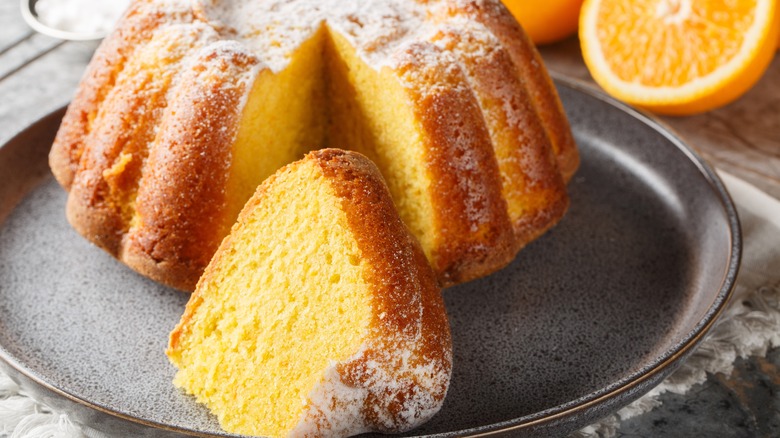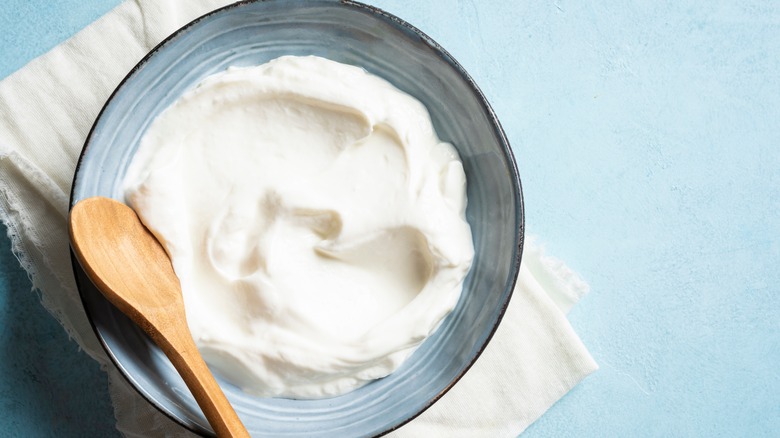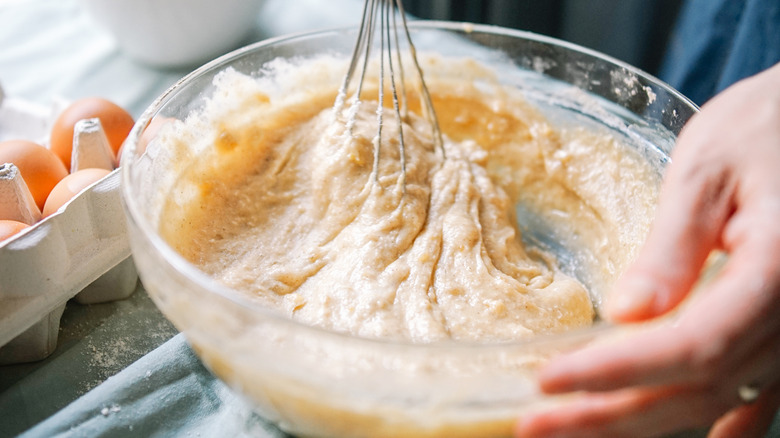Why You Should Be Adding Yogurt To Your Cakes
As the go-to celebratory dessert, cake has a special place in our hearts and at our table — but not all cakes are worth a second slice. A great cake has to be moist and tender and learning how to bake one is sure to make you a hit as a party host or guest. According to baking expert Hana Dreiling, the way to get your cake as tender as possible is to reach for some tangy yogurt.
Dreiling is the Co-Founder and Head Baker of Holey Grail Donuts, whose bake shops in Hawaii and Los Angeles serve fresh, uniquely flavored donuts made from taro dough. When it comes to baking a perfectly textured cake, Dreiling advises for bakers to rely on the inherent richness and moisture you can find in yogurt. Yogurt might seem like an odd choice for baking, since we're more used to eating it directly out of a bowl. But it actually provides great textural benefits to your cake, and can even be used in place of eggs to upgrade boxed cake mix. "Yogurt is a game-changer for cakes. Its tanginess enhances flavor, adding subtle depth and complexity, while its natural acidity helps tenderize the gluten in the flour, leading to a softer texture," Dreiling says. As an added bonus, the rich fat content in yogurt also helps keep your cake moister for longer.
The best yogurt to incorporate into cakes
Like adding buttermilk or sour cream, incorporating yogurt into your homemade cake recipe ups its fat content and cream factor, making for a decedent bite. It's also an ingredient you're likely to have in the fridge already, but if the yogurt you keep in stock is flavored or overly sweetened, avoid baking with it. Instead, Dreiling opts for a plain full-fat yogurt.
"The fat content contributes to richness and a moist crumb, so avoid fat-free varieties, which can lead to drier results," she says. "Also, steer clear of yogurts with added thickeners, artificial flavors, or sweeteners, as they can interfere with the cake's texture and flavor." Baking is a delicate science, so it's important that the yogurt you use does not contain ingredients that will throw off the recipe's chemistry.
Many of the best high-protein yogurts at the grocery store are Greek yogurts, which are strained to remove whey, resulting in a thicker, tangier product. According to Dreiling, Greek yogurt is prized for its creamy consistency, but you may need to adjust the amount of liquid present in the recipe to compensate for this richness.
If you love the extra flavor and moisture that yogurt adds to your cakes, there are a number of ways to incorporate it in other classic dishes, as well. Turn Greek yogurt into homemade pizza dough with the help of self-rising flour, or use it to upgrade your mac and cheese with maximum creaminess. Keep a pint of this fermented staple on hand as the ultimate kitchen hack.
More tips for extra-moist cakes
Yogurt and other creamy add-ins help ensure your cake is moist and rich, but there are a few more tricks to keep in mind to avoid the dry, coarse texture we all dread. Beyond balancing the moisture of your ingredients, Dreiling blames overmixing for bad cake texture. As you stir and work your batter, you risk developing too much gluten in the flour, which can toughen up the cake's crumb.
Inhibiting gluten development is an important step towards a tender cake, which is why some recipes call for low-protein cake flour. The higher your flour's protein content, the more gluten develops during the mixing process. Because mixing is what creates gluten, you want to limit it as much as possible for very light, airy cakes.
The most important final tip from Dreiling? Don't overbake your cake. "Cakes continue to cook slightly as they cool, so pulling them out of the oven just as they're set (or when a toothpick comes out with a few moist crumbs) ensures they stay moist." If you're not planning to eat it right away, further lock in moisture by wrapping and freezing your cake. This traps in the steam that would otherwise be released, making for a perfectly moist slice once thawed.


